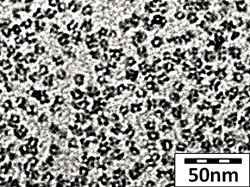 |
| Cornell dots with porous, drug-delivering capabilities--Courtesy of Cornell |
Researchers at Cornell University have created the prototype of a combination drug-delivery and diagnostic nanoparticle that would be the smallest inorganic, silica-based vehicle around.
The dye-infused particles called "Cornell dots" attracted the attention of the FDA in early 2011, and the agency gave Ulrich Wiesner and his team the go-ahead to start clinical trials. At that point, the nanoparticles, C-dots for short, played only a diagnostic role with their ability to target cancer cells and "light" them up with fluorescence, allowing surgeons to identify tumors more easily. Now, the Cornell researchers have shown it's possible to turn these tiny spheres into a drug-delivery platform, as well.
By drilling a hole into the C-dots--which are less than 10 nm in diameter--Wiesner and team have created a vehicle capable of holding cancer drugs. And with the already-proven "stealth" targeting ability of the C-dots, this mesoporous characteristic would make them a formidable delivery mechanism for chemotherapy.
The small size of the C-dots is particularly exciting in the realm of drug delivery, Wiesner told FierceDrugDelivery over the phone, and one of the reasons for the previous FDA approval, he speculates. Rather than circulating in the human body and entering the liver, as larger particles do, the C-dots remain in the body for less than 6 hours and are excreted in the patient's urine. By taking this route, Wiesner said, any unwanted effects of the inorganic vehicles are kept to a minimum.
"It was a question we always asked," Wiesner said. "We have this particle for diagnostic purposes, but could we put a drug in this particle and keep the size below 10 nm? The idea was that this was the first step, and now we are looking at how they will work in vitro."
Because it fits into work the team has already done with C-dots in the diagnostic arena, Wiesner expects a relatively smooth road to clinical trials as they develop the newest iteration.
In other (related) news, Wiesner and team published an article today in Science that illustrates the use of another nanoparticle--one that has multiple, separate compartments to hold different drugs in a single structure. He said these have a ways to go compared to C-dots, and are not as close to the clinic.
- here's Cornell's article
- and here's Wiesner's C-dot website